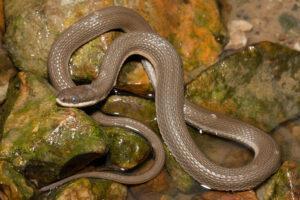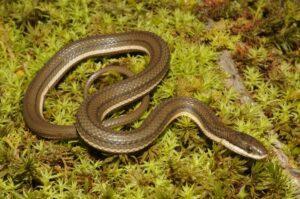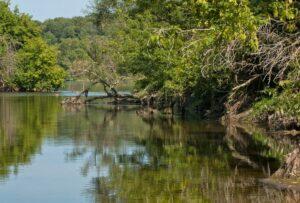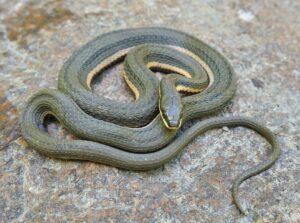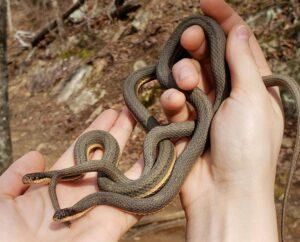The queen snake is a small semiaquatic snake endemic to North America. Other common names of the species are brown queen snake, North American seven-banded snake, moon snake, leather snake, queen water snake, olive water snake, seven-striped water snake, pale snake, striped water snake, willow snake, three-striped water snake, and yellow-bellied snake.
Scientific Classifications
- Suborder:Serpentes
- Family:Colubridae
- Genus:Regina
- Species:R. septemvittata
Conservation Status
Description
Size
The queen snake seldom grows over 24 inches (61 cm) in total length. The females are only slightly larger than the males.
Color and Appearance
Olive to dark brown or gray is the background coloration with yellow or peach stripes running down the length of its body along the first row of scales. Four prominent, darker ventral stripes run down the entire length of its belly. The juveniles have three more stripes – one that runs along the vertebral dorsal scales and two traversing the body at scale rows 5 and 6, one on each side of the body. Hence the specific name, ‘septemvittata’,meaning seven-striped. The additional stripes fade with age. The snake’s belly is cream to yellow colored.
Its head is narrow with 9 large plate-like scales on top, while the chin has several rows of thicker scales. It is a protective adaptation due to its foraging behavior of chasing its prey under rocks. 19 rows of keeled dorsal scales cover its mid-body. It has round pupils and a divided anal plate. Sexual dimorphism is present, with the males having slightly more subcaudals and longer tails. Still, the two sexes are quite difficult to distinguish.
Are They Dangerous to Humans
The seven-striped water snake is very docile and is not likely to bite. It is very alert to any form of danger and enters water whenever it is disturbed. It defends itself by spinning, thrashing, and secreting foul-smelling anal musk and feces.
Queen Snakes at a Glance
Distribution
It inhabits east of the Mississippi river, through the temperate region of North America, ranging from western New York to Wisconsin, south of Alabama, and northern Florida. It is also found in southwestern Ontario. New Jersey used to be in its range, but the species is now believed to be eradicated from there.
The primary cause of a decrease in its population is the loss of its food sources due to bank erosion, stream channelization, and water pollution. Its main food, crayfish, is sensitive to water acidification and the accumulation of heavy metals. So, polluted, drained, and disturbed waterways have killed crayfish leading to the eventual disappearance of the snake from its range.
Habitat
It only lives in areas with watersheds having rocky or stony bottoms and clean, running streams. The minimum temperature of the water should be 50°F during its active months. It spends winters in brumation inside old bridge abutments, bedrock niches, and cracked concrete dams and retaining walls.
Though a diurnal species, the queen water snake also moves and hunts at night. They are frequently found on rocks within or near the streams or brooks they dwell in. They come out of the water to bask in the sun, often perching on roots or branches above or near the water’s edge.
Lifespan
Their lifespan in the wild is unknown. In captivity, they can live for as long as 19 years.
Predators
Otters, raccoons, hawks, mink, and herons eat these snakes. The baby snakes are food for fish and frogs.
Diet
It mainly eats newly-molted crayfish that can’t protect themselves effectively with their pincers. Other food sources are tadpoles, frogs, newts, snails, minnows, and fairy shrimp.
It hunts with its sense of smell, even underwater, using its tongue to carry the scent of its prey to oral receptors.
Reproduction
Ovoviviparous (gives birth to live young from eggs that hatch inside the body)
Females reach sexual maturity at 3 and males at 2 years of age. Breeding occurs in spring and summer. If mating takes place in autumn, the females can delay giving birth till spring, storing their energy through brumation (hibernation). The litter size is 5-20, and the time for giving birth is 1.5-2.5 minutes. 4 minutes to 1 hour is the time gap between individual births, the average being 11 minutes.
The juveniles are 6.9-9.1 inches (17.5-23 cm) long, can swim, move about, and should fend for themselves. They grow very quickly and can molt twice in the first week sourcing their food from nutrient-rich yolk stores that they preserve through this stage of their lives.
Similar Species
The common garter snake, Thamnophis sirtalis, has a mid-dorsal stripe of light color.
Glossy Swampsnake
The thicker glossy swampsnake, Liodytes rigida, is glossy olive brown to brown with dark oblique lines on its neck and a couple of rows of half-moon-shaped spots on its belly.
Source
static.wixstatic.com, msherps.com, joshvandermeulen.blogspot.com, reddit.com, phenology.mwparc.org, happyserpent.com,

